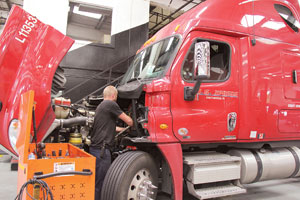Truck Dealers Say Telematics Advancements Can Help Attract New Crop of Technicians

YOUNTVILLE, Calif. — Telematics and mobile communications can help fleets better utilize their equipment and drivers, while providing truck dealerships the ability to more quickly make repairs and stock replacement parts.
The technologies also are beginning to help tackle another critical issue facing the industry — the growing shortage of technicians at truck dealers and fleets.
Some experts estimated that 200,000 new technicians may be needed over the next decade to accommodate growth in the freight transportation industry and to replace those nearing retirement.
“It is hard to find enough technicians because many in the younger generation don’t want to get their hands dirty — they would rather be involved in electronics,” said Friedrich Baumann, senior vice president of aftermarket for Daimler Trucks North America.
From DTNA’s recent investment in Zonar Systems to the autonomous-driving Freightliner Inspiration truck event earlier this year, it is showing them that “this is actually an industry where they will be much more exposed to electronics than they ever thought. That is helping draw people into our industry,” Baumann told Transport Topics.
Baumann made the comments July 28 during a media event here that included a panel discussion with three DTNA truck dealers and a fleet executive.
Rich Reynolds, president and dealer principal of Peach State Truck Centers, said he has been struggling to find new technicians compared with 15 to 20 years ago, because the number of students that see “being a technician as a career worth pursuing is not as prevalent.”
Reynolds said he has developed relationships with vocational schools — and even high schools — to attract candidates who are interested in learning about how quickly the industry is evolving technologically.
Similarly, Brad Fauvre, president of the Velocity Vehicle Group, said he tries to pair junior technicians at his locations with more experienced ones so they can learn on the job at a faster pace. He agreed the technician shortage is a problem “that is not going to go away quickly,” but added, “sometimes we overblow these challenges.”
“There were those predictions 10 years ago, and Daimler’s share in that time has gone up about 50% and somehow we have enough technicians to fix the trucks,” he said.
Fauvre said he has ex¬panded his technician count to about 80 from 45 a few years ago, and through best practices developed out of DTNA’s Elite Support Network program, he has been able to cut average throughput time in the shop from more than four days to less than three days.
In the shops, the focus is on “taking the waste out of the technicians’ day and making sure the part is there so they can quickly make the fix and move on to the next job,” Fauvre said.
The efficiency improvements also have been achieved through investing millions of dollars to reorganize the layout of some of the older shops that in some cases date to the 1970s.
Scott Pharr, owner of Piedmont Truck Center in Greensboro, North Carolina, said the changing face of maintenance shops includes something far more simple than some of the latest technology.
“Truck dealerships can get dirty really quickly,” he said. “We want to eliminate clutter to present the dealership to the customer the way you want it to be presented.”
Also participating in the panel was Ray Hufnagel, president of trucking fleet Plastic Express, based in City of Industry, California. He is a large customer of Velocity and said the improvements at the dealership have had a trickle-down effect on his fleet.
Hufnagel said his company has moved to full-service maintenance leases, allowing him to scale back his maintenance team “down to basically having one guy here and there to help with scheduling. It works really well for our business model.”


